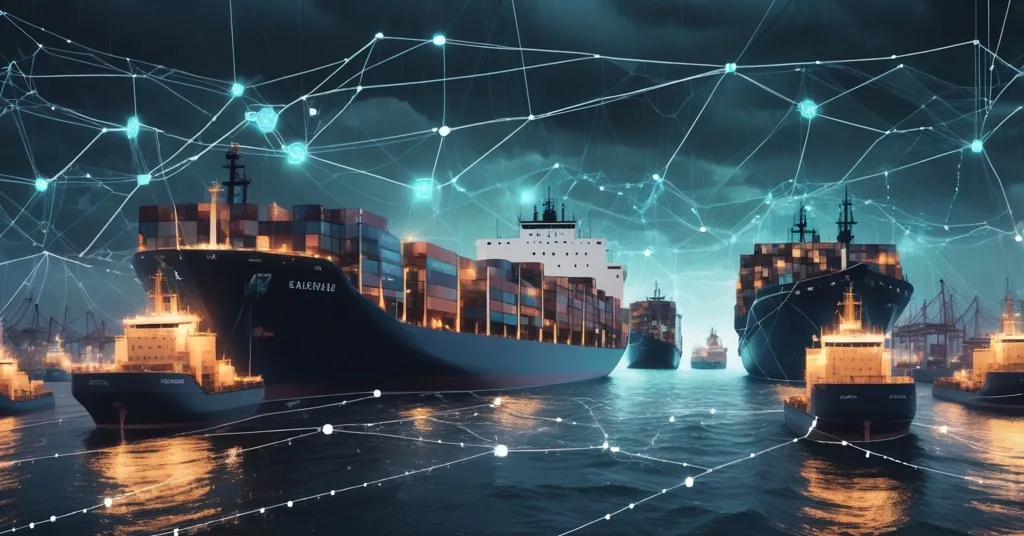U.S.-China Port Fees Disrupt Trade: Can Blockchain Save Global Supply Chains?

U.S.-China Port Fees Disrupt Global Trade: Could Blockchain Be the Fix?
New port fees imposed by the U.S. and China on October 14 have triggered a sharp drop in cargo ship availability, sending shockwaves through global supply chains. This latest escalation in trade tensions is forcing shipping companies to reroute vessels, spiking freight rates, and raising alarms about higher consumer prices. But could decentralized technologies like blockchain offer a way to bypass such centralized chaos?
- Fee Fallout: U.S. and China port fees have slashed cargo ship numbers at key ports, disrupting trade flow.
- Rate Surge: Freight costs on transpacific routes jumped, with the Shanghai Containerized Freight Index (SCFI) up 12.9%.
- Decentralized Hope: Blockchain could offer transparent trade solutions, though challenges persist.
The Port Fee Crisis Unpacked
The core of this mess lies in retaliatory port fees rolled out by the U.S. and China, targeting ships with ties to the other nation. If a vessel is U.S.-flagged or operated, it faces extra charges docking at Chinese ports, and the same applies to Chinese-linked ships at U.S. ports. The fallout is immediate: shipping giants like Maersk and Hapag-Lloyd, under their Gemini Alliance partnership, are rerouting vessels to dodge these costs. Ships such as the U.S.-flagged Maersk Kinloss and Potomac Express are now avoiding Ningbo, a critical Chinese port. This isn’t just a slight detour—it’s a logistical nightmare, with fewer ships docking, cargo volumes shrinking, and delays piling up faster than rush hour in L.A.
For those not steeped in shipping lingo, let’s break it down. Transpacific routes are the major shipping lanes between the U.S. and Asia, carrying everything from smartphones to sneakers. The Shanghai Containerized Freight Index (SCFI) is like a stock ticker for shipping costs, tracking the price of moving containerized goods. When it surges by 12.9% to a four-week high, as reported by Jefferies analyst Omar Nokta, it means transporting goods just got a lot pricier. And the opacity around these fees? Shipping companies don’t even know how the charges are calculated, turning budgeting into a high-stakes guessing game.
Then there’s the impact on very large crude carriers (VLCCs)—massive tankers, often over three football fields long, that haul up to 2 million barrels of crude oil. With China as the world’s largest crude oil importer, any hiccup in VLCC routes hits hard. Benchmark rates for these giants spiked to a two-week high on October 14 before dipping slightly, but consultancy Energy Aspects has already bumped up its Q4 2025 rate forecasts, expecting more turbulence if disruptions worsen. Higher shipping costs for oil translate to pricier gas at the pump and costlier plastics in everyday goods. It’s a ripple effect you can’t ignore.
Here’s a kicker: Chinese-built ships are exempt from these fees, a move that screams strategic self-interest to prop up domestic industry, as noted by Gibson Shipbrokers. Meanwhile, U.S.-owned or operated vessels are left bleeding cash. This isn’t just unfair—it’s a blatant middle finger to free trade principles, favoring one side while the other scrambles. The lack of clarity on fee structures only adds insult to injury, leaving American firms navigating a storm without a compass.
Impact on Global Trade and Consumers
The pain isn’t confined to shipping lanes. Transpacific routes, the artery of U.S.-China trade, are under severe strain, and the broader global supply chain—still wobbly from post-pandemic chaos and geopolitical spats—is taking another hit. Imagine a small U.S. retailer waiting on holiday inventory from China. Now, they’re staring at weeks of delays and a fatter bill. A 10% hike in shipping costs could easily bump your next laptop purchase by $50 or make that winter jacket sting a bit more.
Industry leaders aren’t sugarcoating the fallout. Stamatis Tsantanis, CEO of Seanergy Maritime Holdings, a dry bulk shipping company, put it bluntly:
“All these charges might eventually be passed on to consumers… this would, in turn, make things more costly.”
He’s dead on. Shipping firms don’t absorb these hits—they pass them down the line until they land in your wallet. Gernot Ruppelt, CEO of Ardmore Shipping, which moves petroleum products and chemicals, doubled down on the operational chaos:
“This new regulation will cause more interference to vessel operations and trade.”
Even companies like Ardmore, not currently docking in China, feel the indirect sting through market-wide shifts. Other big players like CMA CGM are also tweaking routes, tangling an already strained logistics web further. This comes on the heels of past U.S.-China trade wars, like the 2018 tariff battles, which jacked up costs for everything from electronics to soybeans. History shows that when superpowers play hardball, consumers foot the bill.
Blockchain as a Disruptor: Potential and Pitfalls
While consumers brace for price hikes, could decentralized technology like blockchain offer a way out of this centralized mess? At its core, blockchain—the tech behind Bitcoin—promises transparent, tamper-proof records that don’t rely on meddling middlemen or geopolitical gatekeepers. Imagine a shipping contract executed via a decentralized platform: no port fees dictated by national spats, just peer-to-peer agreements locked on an immutable ledger. Tokenized cargo tracking could ensure real-time visibility without bureaucratic red tape, potentially sidestepping disputes like these U.S.-China fee wars.
Real-world experiments already hint at this future. Maersk, one of the very companies hit by these fees, previously piloted TradeLens, a blockchain-based supply chain platform with IBM. Though TradeLens shut down in 2023 due to adoption struggles, it showed how digital ledgers can streamline documentation and cut fraud. Other projects, like VeChain, are tackling supply chain transparency, tracking goods from factory to shelf. Walmart’s blockchain trials for food safety also prove the tech can work at scale in niche areas. For Bitcoin maximalists, this resonates with the ethos of cutting out overbearing systems—whether financial or logistical.
But let’s not get carried away with starry-eyed optimism. Blockchain isn’t a silver bullet for trillion-dollar trade networks. Scalability remains a beast—most blockchains can’t handle the transaction volume of global shipping. Adoption is another hurdle; getting every stakeholder, from port authorities to small carriers, on board is like herding cats. And while Bitcoin’s push for economic freedom is inspiring, applying it to physical trade logistics is a whole different game. The tech might resist centralized overreach, but it’s not ready to untangle global supply chains overnight. Still, every centralized fiasco like this port fee debacle underscores why we need to double down on decentralized alternatives, flaws and all.
Challenges to Decentralized Trade Solutions
Digging deeper, the road to blockchain-driven trade isn’t just bumpy—it’s littered with landmines. Beyond scalability, interoperability is a nightmare. Different blockchain platforms often don’t play nice together, and integrating them with legacy shipping systems is like fitting a square peg in a round hole. Then there’s the cost: building and maintaining decentralized infrastructure isn’t cheap, especially for smaller players who can’t afford the upfront investment. And let’s not forget regulatory pushback—governments aren’t exactly thrilled about tech that bypasses their control. Just look at how crypto regulations keep tightening; a blockchain trade system could face similar chokeholds.
On the flip side, playing devil’s advocate, these port fees might force innovation in unexpected ways. Could they push shipping firms to explore alternative routes or efficiency tweaks outside the blockchain realm? Possibly. But short-term pain often drowns out long-term gain, and right now, the pain is raw. Higher freight rates and delays aren’t abstract—they mean pricier gadgets, slower deliveries, and tighter budgets for millions. Decentralized tech offers a tantalizing “what if,” but the hard reality of implementation keeps it a distant dream for now.
Looking Ahead: Trade Wars and Decentralized Hopes
Zooming out, this port fee clash is a brutal reminder of how fragile global trade is when superpowers flex muscle. It’s not just about ships or routes—it’s about cascading effects on economies, consumers, and even tangential sectors like crypto. As trade wars inflate costs, Bitcoin’s narrative as an inflation-resistant asset might gain traction, if it can shake off its own volatility baggage. These disruptions highlight the flaws of centralized control, reinforcing the urgency of systems that resist geopolitical overreach, even if they’re not perfect yet.
Will these fees stick, spike further, or spark some workaround? That remains to be seen. What’s clear is that while Bitcoin won’t solve shipping delays tomorrow, its underlying ethos of escaping centralized chokeholds feels more relevant with every trade spat. If centralized policies keep choking global economies, isn’t it time we push harder for decentralized tech, warts and all? Adaptability is the name of the game, in trade as in crypto, and we’ll be watching closely to see who adapts first.
Key Takeaways and Questions
- What’s causing the cargo ship shortage at U.S. and Chinese ports?
New port fees introduced on October 14 by the U.S. and China, as detailed in reports on reduced cargo ship numbers, are pushing shipping companies to detour vessels, cutting availability at major ports and snarling supply chains. - How are these fees affecting freight costs and trade routes?
Freight rates on vital transpacific routes have soared, with the Shanghai Containerized Freight Index spiking 12.9%, raising the cost of moving goods between the U.S. and Asia. - Why should consumers worry about this latest U.S.-China trade clash?
Increased shipping costs and delays will likely drive up prices for everyday items like electronics, clothing, and gas, as companies pass the burden to shoppers. - Can blockchain provide solutions to global supply chain disruptions?
Decentralized supply chain tech on blockchain could enable transparent, trustless trade systems to bypass centralized disputes, though scalability and adoption are major obstacles. - How does this trade mess align with Bitcoin and decentralization’s principles?
It exposes the failures of centralized control, bolstering Bitcoin’s mission for economic freedom and systems immune to geopolitical meddling, even if crypto isn’t a direct fix for shipping woes.



